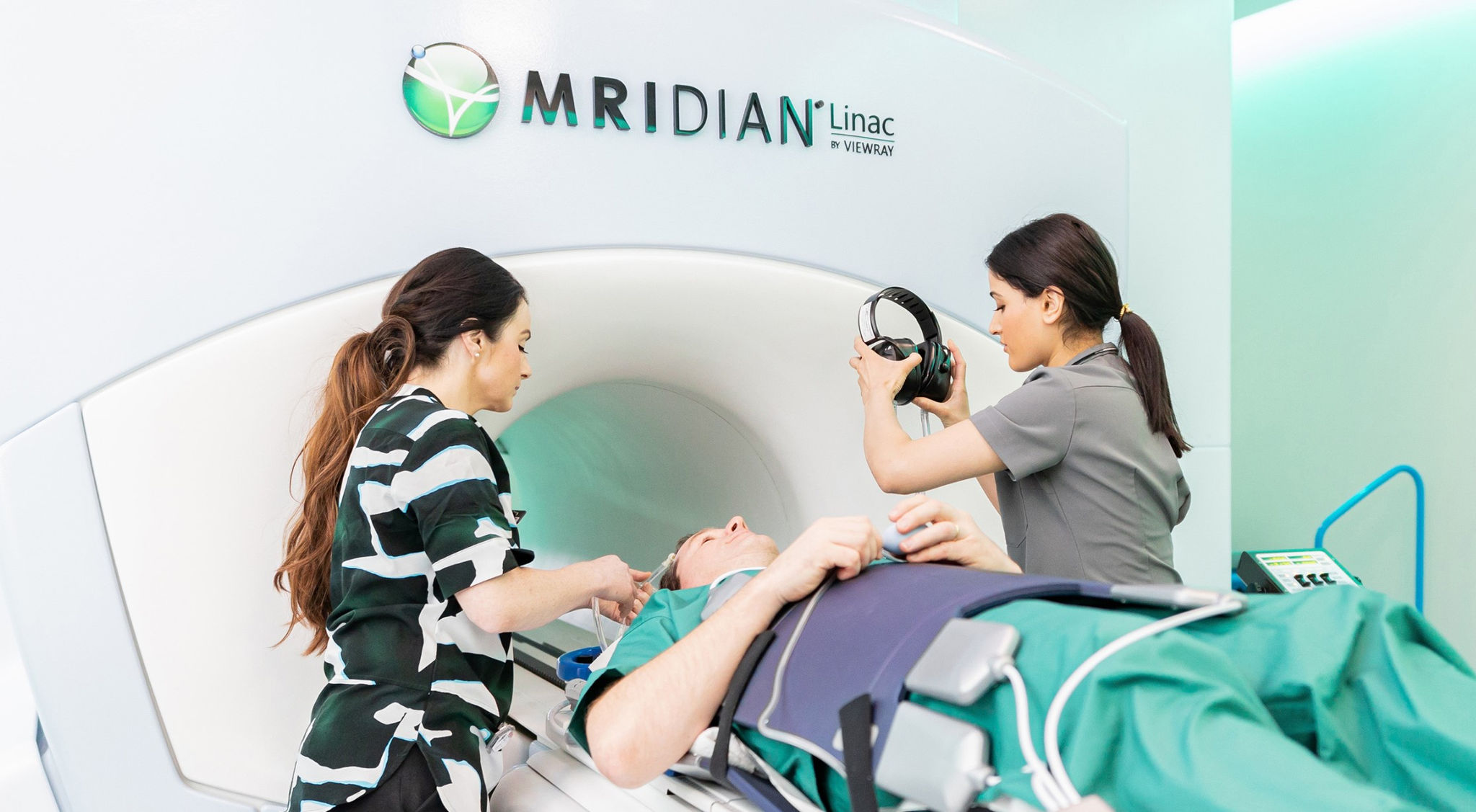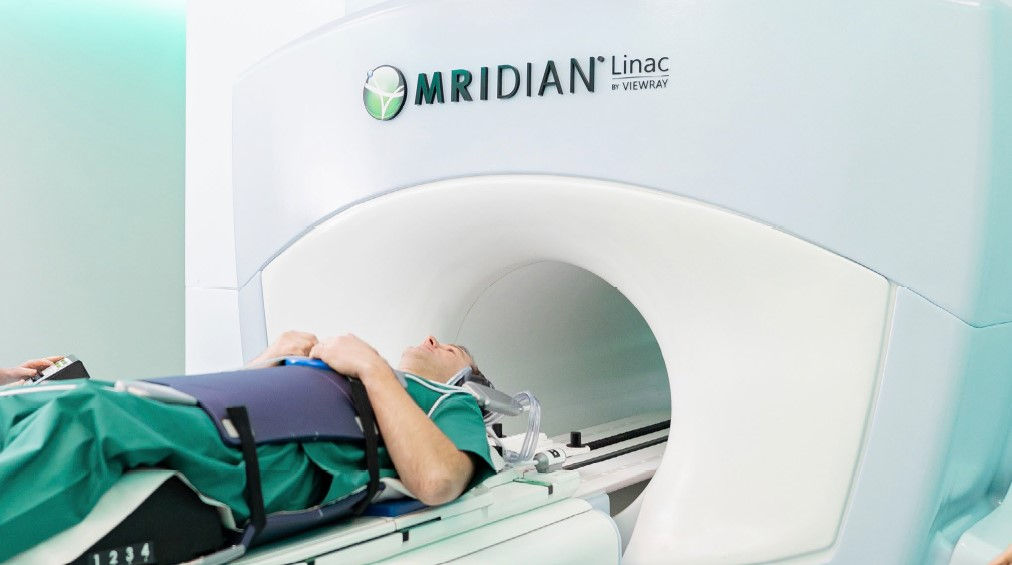- Healthcare Professionals
- Oncology
- Treatments
- Radiotherapy
- simultaneous integrated boost for prostate cancer
What is simultaneous integrated boost?
Simultaneous integrated boost (SIB) with MRI-guided 5 fraction (5#) SABR for prostate cancer is a cutting-edge radiotherapy treatment option available on the MRIdian MR Linac at our centres in Oxford and London.
SIB used with 5# SABR aims to improve outcomes by providing an escalated focal boost of radiotherapy to the dominant intraprostatic lesion (DIL), recognised as the region of the prostate most often associated with local recurrence.1–3
Delivered with MRI guidance on the MRIdian, radiotherapy for prostate cancer usually delivers a uniform dose to the entire prostate gland. Although higher doses are associated with improved efficacy, dose escalation is limited by the risk of genitourinary (GU) and gastrointestinal (GI) toxicity. SIB, delivered with MRI-guidance on the MRIdian offers the potential for dose escalation to the DIL with high accuracy, preserving other areas from undue exposure.
Refer a patient
Making a referral is easy. Please complete our online referral form or request a call back.
Benefits for patients with prostate cancer
Innovative treatment
SIB with MRI-guided 5# SABR is a cutting-edge radiotherapy strategy, designed to improve long-term outcomes and minimise recurrence for patients with prostate cancer.
Favourable safety profile
MRI guidance provides high accuracy, minimising the risk of side effects.
Convenient treatment schedule
MRI-guided 5# SABR with SIB is delivered in just five treatment sessions, offering convenience for patients and minimal impact on quality of life.

Evidence base for simultaneous integrated boost
The rationale for a focal boost strategy is supported by recent data from the Phase III FLAME trial (Focal Lesion Ablative Microboost in Prostate cancer). In this study, over 500 patients with intermediate or high-risk prostate cancer were randomised to receive a standard treatment regimen of 77 Gy in 35 fractions, or standard treatment plus an integrated boost to the tumour to a total dose of 95 Gy in 35 fractions. Patients who received the targeted boost plus standard treatment had improved outcomes, including biochemical disease-free survival, failure-free and local and distant metastasis-free survival compared to those who received the standard treatment alone. There were no significant differences between treatment arms in toxicity 5,6 or quality of life.6
Using a focal boost in a hypofractionated regimen was tested in the Phase II Hypo-FLAME trial (Hypofractionated Focal Lesion Ablative Microboost in Prostate Cancer). In this study, 100 patients with intermediate- or high-risk prostate cancer received SABR radiotherapy of 35 Gy in 5 fractions, with SIB to a tumour visible on MRI up to 50 GY. The treatment regimen was found to be possible with acceptable GU and GI toxicity.
In the later Hypo-FLAME 2.0 trial, it was shown the treatment schedule could safely be reduced from 29 to 15 days.
Treatment schedule
Under the treatment schedule, 40Gy in 5 fractions is delivered to the prostate Clinical Target Volume (CTV) with an added boost to the DIL up to a total maximum of 45Gy in 5 fractions. This is limited by the dose to the urethral planning risk volume (PRV) and other nearby organs at risk.
Prostate patient eligibility
SIB is available for patients with high-risk prostate cancer who are eligible for treatment with MRI-guided 5# SABR on the MRIdian MR linac.
What are the inclusion criteria?
- Aged 18 years or older
- WHO performance score 0-2 or Karnofsky performance status 70-100%
- Biopsy-proven adenocarcinoma of the prostate
- ISUP Grade Group ≥3 (including Gleason 4+3=7, 4+4=8, 4+5=9, 5+4=9, 5+5=10)
- DIL visible on MRI and/or PSMA PET scan
- Prostate volume ≤ 90 cc on transrectal ultrasound (TRUS)
- International Prostate Symptoms Score (IPSS) ≤19
- T-stage: T2-T3b (on MRI and/or endorectal ultrasound)
- Posterior lesions will require a rectal spacer as determined by USAT. If the DIL is breaching the capsule posteriorly or involves the seminal vesicles, treatment will be precluded as a rectal spacer will be contra-indicated
- No evidence of lymph node or distant metastases on radiological staging. Staging will require mpMRI and PSMA PET scan unless there is a specific contraindication to either of these modalities
- All patients should be able to undergo MRI scans
- Reviewed by Urology SABR Advisory Team (USAT) to confirm external beam radiotherapy is an option for treatment
- Previous TURP is allowed provided there is at least eight weeks interval with radiotherapy
- The administration of concomitant hormonal therapy is allowed
What are the exclusion criteria?
- Previous irradiation in the pelvic region
- Previous prostatectomy
- Previous focal therapy to the prostate (HIFU or Cryotherapy)
- T4 disease
- Previous HoLEP or TURP in previous 6 months
- Patient without a visible area of disease on mpMRI or PSMA PET
- Patients where pelvic nodal irradiation is deemed necessary by the treating clinician
- Contraindications for MRI
- Patients who have electronic devices such as pacemakers or implanted defibrillators, deep brain stimulators, cochlear implants
- Patients who have a metallic foreign body in their eye
- Patients who have an aneurysm clip in their brain
- Patients with severe claustrophobia may not be able to tolerate an MRI scan
- Patients with inflammatory bowel disease
How to refer
What information is needed to refer a patient for SIB on the MRIdian?
For all referrals, clinicians should provide:
- Prostate radiotherapy consent form
- MR linac supplementary consent form
- Booking form (electronic/paper)
- Referral letter (referring the patient to the clinical oncologist)
- Histology report
- Prostate MRI report and images if possible
- GenesisCare MRIdian assessment pro forma
- Please note some insurers may ask for a medical report.
Clinicians with credentials for SABR treatment for prostate on MRIdian can refer directly using the same process as for routine prostate patients. All cases will be reviewed by the Urology SABR Advisory Team (USAT). Radiotherapy plans will be peer reviewed.
Refer a patient
Making a referral is easy. Please complete our online referral form or request a call back.
References
- Cellini N, Morganti AG, Mattiucci GC, Valentini V, Leone M, Luzi S, et al. Analysis of intraprostatic failures in patients treated with hormonal therapy and radiotherapy: implications for conformal therapy planning. Int J Radiat Oncol Biol Phys [Internet]. 2002 Jul 1;53(3):595–9. Available from: https://doi.org/10.1016/S0360-3016(02)02795-5
- Arrayeh E, Westphalen AC, Kurhanewicz J, Roach M, Jung AJ, Carroll PR, et al. Does local recurrence of prostate cancer after radiation therapy occur at the site of primary tumor? Results of a longitudinal MRI and MRSI study. Int J Radiat Oncol Biol Phys. 2012 Apr 1;82(5).
- von Eyben FE, Kiljunen T, Kangasmaki A, Kairemo K, von Eyben R, Joensuu T. Radiotherapy Boost for the Dominant Intraprostatic Cancer Lesion – A Systematic Review and Meta-Analysis. Clin Genitourin Cancer [Internet]. 2016 Jun 1;14(3):189–97. Available from: https://doi.org/10.1016/j.clgc.2015.12.005
- 4. Benitez CM, Steinberg ML, Cao M, Qi XS, Lamb JM, Kishan AU, et al. MRI-Guided Radiation Therapy for Prostate Cancer: The Next Frontier in Ultrahypofractionation. Vol. 15, Cancers. Multidisciplinary Digital Publishing Institute (MDPI); 2023.
- Monninkhof EM, van Loon JWL, van Vulpen M, Kerkmeijer LGW, Pos FJ, Haustermans K, et al. Standard whole prostate gland radiotherapy with and without lesion boost in prostate cancer: Toxicity in the FLAME randomized controlled trial. Radiotherapy and Oncology. 2018 Apr 1;127(1):74–80.
- Kerkmeijer LGW, Groen VH, Pos FJ, Haustermans K, Monninkhof EM, Robert ;, et al. Focal Boost to the Intraprostatic Tumor in External Beam Radiotherapy for Patients With Localized Prostate Cancer: Results From the FLAME Randomized Phase III Trial. J Clin Oncol [Internet]. 2021;39:787–96. Available from: https://doi.
- Draulans C, van der Heide UA, Haustermans K, Pos FJ, van der Voort van Zyp J, De Boer H, et al. Primary endpoint analysis of the multicentre phase II hypo-FLAME trial for intermediate and high risk prostate cancer. Radiotherapy and Oncology [Internet]. 2020 Jun 1;147:92–8. Available from: https://doi.org/10.1016/j.radonc.2020.03.015
- De Cock L, Draulans C, Pos FJ, Isebaert S, De Roover R, van der Heide UA, et al. From once-weekly to semi-weekly whole prostate gland stereotactic radiotherapy with focal boosting: Primary endpoint analysis of the multicenter phase II hypo-FLAME 2.0 trial. Radiotherapy and Oncology [Internet]. 2023 Aug 1;185. Available from: https://doi.org/10.1016/j.radonc.2023.109713
